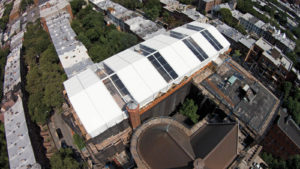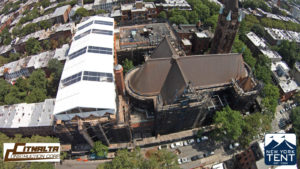
New York Tent installs a rooftop structure that couldn’t be attached to the roof.
When Citnalta Construction Corp. approached Long Island-based New York Tent to cover a roof that it needed to rip off and replace, the construction firm had one big caveat: because of the work that had to be done, the tent couldn’t rest on the roof itself.
“They had spoken to other tent and structure companies, but those companies didn’t feel confident and ultimately passed on the job,” says David Tannenbaum, CEO of New York Tent.
New York Tent turned to Losberger for engineering guidance on installing a Uniflex structure that would be secured to scaffolding. A Losberger engineer determined that additional customization would need to be fabricated to withstand the various forces based on the height, placement and duration of the rental.
“Once this step was complete, the engineering was passed to the scaffold engineer,” Tannenbaum says. “The scaffold engineer created a design that would allow the loads to be transferred to the scaffold and not the roof. This included tons of steel I beams, custom steel tie-backs, cross bracing, cabling and much more.”
 The resulting installation was a custom-engineered 20-by-60-by-3.4-meter structure with a mix of white and clear tops and gables.
The resulting installation was a custom-engineered 20-by-60-by-3.4-meter structure with a mix of white and clear tops and gables.
“This translates into roughly 13,200 square feet safely installed, permitted and very visible in the Brooklyn skyline,” Tannenbaum says.
Aside from the custom engineering, most of the challenges with this installation revolved around working safely on scaffold 66 feet in the air.
Because of the height and wind vulnerability of the site, there were a few days when work could not proceed safely. Each day, the weather forecast was monitored to determine if it would be safe to work the next day.
“The installation staff had to obtain certifications, attend safety classes and become familiar with specialty safety equipment,” Tannenbaum says. “Help from the union and safety managers enabled us to make this project go from a vision to a reality.”
The timeline was initially communicated to New York Tent with the term “ASAP”—another challenge that New York Tent faced head-on.
“It motivated our team, to say the least,” Tannebaum says. “In the end, once we figured out the engineering and safety concerns, the structure was installed in just a few weeks.”
Tannenbaum admits that some of his own team was skeptical at first, but if you ask them now, they would describe this job as “an easy one,” he says.
“In the past, New York Tent was always regarded as a ‘go to’ resource for high-end tenting and event solutions,” he says. “This project has already opened doors that might not have been open prior. In the New York market we have plenty of good competition. Projects like this will help elevate us beyond the others.”
 TEXTILES.ORG
TEXTILES.ORG


